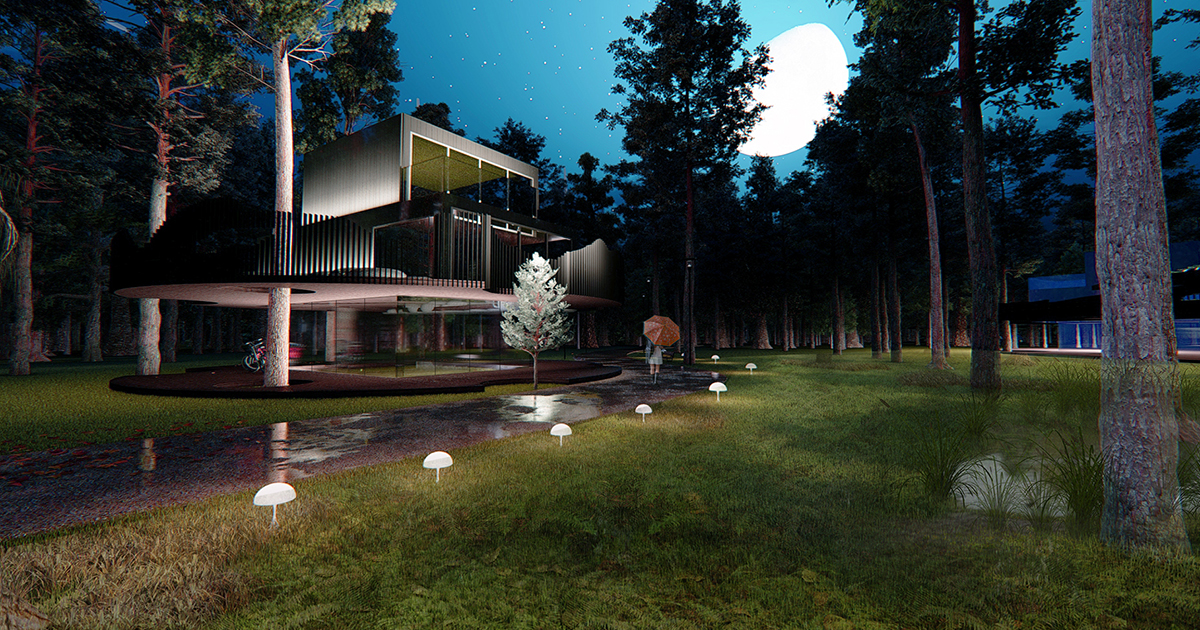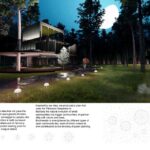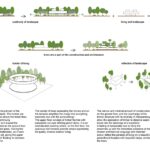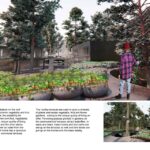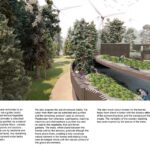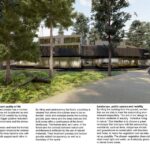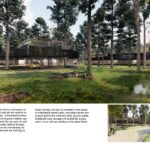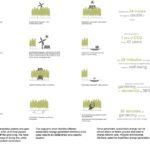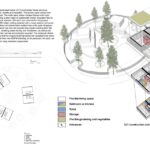Living in Nature | UArchitects | World Design Awards 2022
UArchitects: Winner of World Design Awards 2022. We have developed an idea that will pave the way for the organic and open growth of collective living, a way of life envisaged by people who want to create communities in leafy surroundings.
To us, living with others and in harmony with nature was an important starting point for the concept: collective living in nature
Inspired by our idea, we produced a plan that uses the Fibonacci Sequence to facilitate the natural evolution of small communities into bigger communities, in partnership with nature and trees. Biodiversity is strengthened by different types of open community too, each of which makes its own contribution to the diversity of green planting.
Collective living is an integral part of the architecture and the nature. The homes are perched on an elevation above the forest floor, the forest landscape continuing uninterrupted beneath and around the houses.
The exterior walls on the ground floor are made out of mirrored glass, making the plinth of the home de-materialise, as it were. It seems not to exist at all, giving the upper floors an appearance of ‘floating’ in between the trees and the ground. The variety of trees separating the homes and on the terraces amplifies the image that everything becomes one with the surroundings.
The upper floor consists of timber frames with panoramic cut-outs offering grand views. It is an omni-faceted building where, on the first floor, the spacious roof terraces provide ample opportunity for quality, diverse outdoor living.
Biodiversity is a key feature on the roof terraces, including a common vegetable and fruit garden on the first floor; the possibility for residents to cultivate their own fruit, vegetables and herbs adds to this unique quality of living. The vegetable garden and the other plants receive rainwater, as well as water from the greywater system.
Each home has a spacious balcony and access to communal terraces. The rooftop terraces are used to grow a diversity of plants and create vegetable, fruit and flower gardens – adding to the unique quality of living on offer. Flowering grasses planted in gardens on the communal roof terraces attract butterflies, insects and bees. Insect hotels and bird baths are set up on the terraces as well and bird boxes are put up on the homes and the trees nearby.
Rainwater is captured and redirected to an underground rain tank via a gulley (wadi). The greenery on the roof terrace/vegetable gardens ensures that rainwater is absorbed slowly. Rainwater is also purified via a natural purification system (helophyte filter) – consisting of a layer of sand, plants and bacteria – making it suitable for re-use by residents and for the gardens on the terraces. Any remaining water is stored in underground water tanks and used when necessary.
We also propose the use of compost toilets; the water from them can be extracted and purified and the remaining ‘product’ used as compost. Wastewater from showers, washbasins, washing machines and dishwashers is purified too and re-used in the vegetable, fruit and flower gardens.
The trees, which stand between the homes and on the terraces, protrude through the floors above them, creating a truly wondrous natural element in the homes and making living here an integral whole with the natural context of this green environment. This makes also healthy living possible: spending a few hours a day in nature significantly reduces stress levels (Japanese forest bathing).
The dark wood colour chosen for the homes helps them blend in better with the shadow effect of the surrounding trees and the background they create. The verticality of the wooden cladding has been inspired by the texture of the trees.
Architectural quality and quality of life
The plot of land selected already has a number of trees on it. Other trees will be planted as well, to compensate for the CO2 created by building work and also attain a bigger positive reduction of CO2 in our living environment and the atmosphere.
The trees situated between and near the homes will form part of the support structure for exterior decking. In this way, the trees become one with the architecture and both support each other in the look created.
By lifting and cantilevering the floors, a building is created that allows the outdoor area to be extended. Voids and recesses inside the building provide open views and the trees between the built areas offer a continuance of the forest landscape. The homes land, as it were, in the forest and the contrast between nature and architecture is softened by the use of natural materials. Their treatment process and texture provide added transparency as well as a boundary of the space.
The narrow and minimal amount of construction on the ground floor, and the overhangs of the timber structure with its diversity in transparency, allow the application of timber to dissolve seamlessly into a woodland. In particular, the ambivalence of the lighting on the ground floor and the apparent heaviness of the floor above it give an interesting answer to the building’s location. A feeling of temporality due to lifting the ensemble up and the immediate presence of the chosen architectural language and material/colour reflect the paradox of living on a beautiful green/forest location with beautiful vistas, amidst the trees.
Landscape, public spaces and mobility
By lifting the building from the ground, we feel that we are able to treat the surrounding environment respectfully. The aim of our design is to allow residents to actually “collective living in nature ”.
Our intention is to choose a green landscape that is in sync with the surrounding woodlands, such as ferns, indigenous shrubs and groundcover in combination with boulders and moss, to make the vegetation look as natural as possible. The chosen vegetation does not need much light and water, as it naturally grows in dense forest areas. An irrigation system will be installed to ensure that plants growing in areas where water has difficulty reaching, are watered.
the parking spaces provide a natural boundary between public and private areas
The community benefits from a communal car park, because of which cars do not need to be parked under the homes. Convenient communal electric transport and bicycles enables residents to travel to and from the car park as well.
The building itself is already defined through its own space. Everyone will immediately experience the area underneath the building as their own.
Water storage will also be installed in the shape of a helophyte pond (wadi), including natural and suitable plants like reed and other aquatic plants. Additional water storage will be built for a greywater circuit with an overflow to the green fields
Materials
The homes have a cross laminated timber (CLT) and timber frame structure. This construction is flexible, healthy and reusable. The timber used comes from well-managed forestry areas. The walls have timber window frames with triple glazing and the wall cladding is also made of sustainable timber. Insulation that is applied is cellulose, a natural material. We don’t use concrete for this project.
Roofs are covered in EPDM rubber roofing material with a moss-sedum roof covering. Research shows that this roof construction method has a life cycle of approximately 50 years. The material can also be recycled.
Any waste resulting from the production of membranes, sheeting waste during roof installation, as well as old foil seals that are demolished, can be economically recycled. The molecule chains are broken down again, so that the original building blocks are revealed once more, allowing new mixtures, and thus new EDPM sheeting, to be produced. As such, we can comply with our goal of using materials responsibly.
Water
We only use “open site paving” or grass block paving. The homes are equipped with a green roof with a variety of terraces on the floors. Water drainage from the terraces flows at a slight slope to drainpipes.
A greywater system will be installed for the residences. Rainwater is captured through a helophyte filter in an underground water tank, which is connected to a greywater and irrigation system.
Health, comfort, sustainability and data
Natural materials that offer warmth in appearance, flexibility in the floor plan, excellent insulation and ventilation, ample daylight, safety, acoustic insulation as well as resonance damping, all contribute to a healthy living environment. All these factors have been taken into account with our design. The selected option to terraces on the upper floor certainly contributes to a sense of secure living in the forest.
The wet areas are – because of the pipe system – in a fixed location. All other spaces can be flexibly arranged and are adaptable. We will provide extensive assistance to the future residents in this respect, and will give them sound advice on how they can make optimal use of the freedom and flexibility of these homes. Even space sharing (shared living) or setting up an office/atelier/guest room are among the many possibilities that these homes have to offer.
We will only be able to process data and monitor quality of life if residents give us permission to do so. An app would be an excellent way of doing this.
Flexibility and Open Building System
The cubic content of our extendable modular building system can be increased or decreased as required. The diagrams attached show how this works with single and double-type homes.
A vertical shaft makes it easy to connect up the plumbing necessary for sanitary facilities and kitchens, while the Open Building System gives future residents a say on how they lay out and use their homes. As architects, it’s our job to help future users make the best choices possible for their particular lifestyles.
Energy
A number of energy-generation options are open to us. The main object is for us to help people achieve their dream: off-the-grid living. We have come up with various ways of doing this, while also providing for the location-dependent generation of energy. The diagrams show that the different sustainable energy generation solutions to be used need to be established on a location-by-location basis. Once generated, sustainable energy can be stored above or below ground and used to charge electric cars, mopeds and bicycles.
We have opted for fossil-free energy generation.

Project Details
Firm
UArchitects
Architect/Designer
Misak Terzibasiyan
Project Name
Living in Nature
World Design Awards Category
Residential Concept
Project Location
South of France
Team
UArchitects
Country
The Netherlands
Photography ©Credit
©UArchitects
![]() UArchitects and Misak Terzibasiyan
UArchitects and Misak Terzibasiyan
The founder and principal Architect of UArchitects, Misak Terzibasiyan, is personally and professionally focused on an international context as well as on the influence of cultural themes. This is mainly based on his ethnical background, as Misak Terzibasiyan was born in Helsinki (Finland).
UArchitects is an international studio that welcomes different nationalities. Our investigative attitude is expressed in the intensive dialogue we undertake with our clients. The scope for reflection is not confined to the projects themselves; we also look into the wider cultural context of architecture and urban development. We are making a social contribution, investigating the position and responsibilities of the architect.
He is the author of the book: Experience and Meaning of Architecture (2021) and Experience of Architecture and Art “An Architect’s Journey” (2022)



